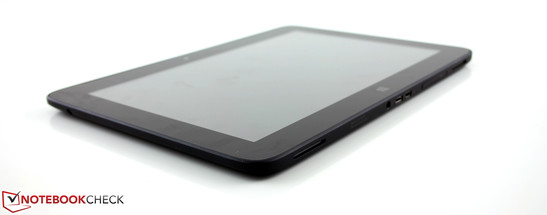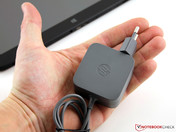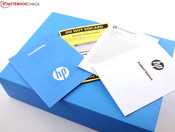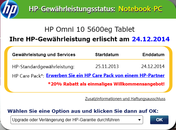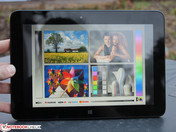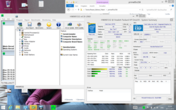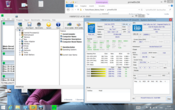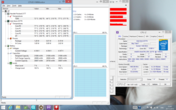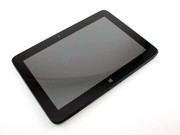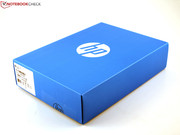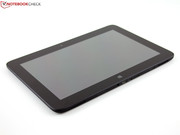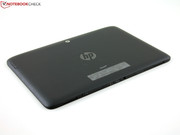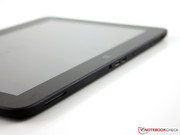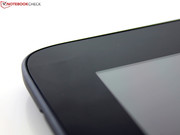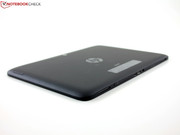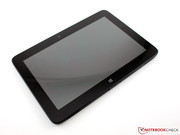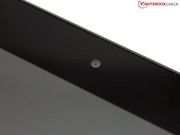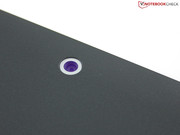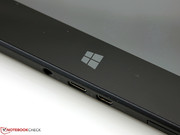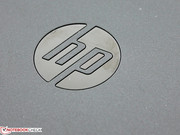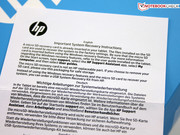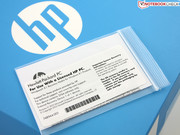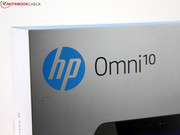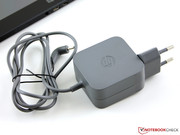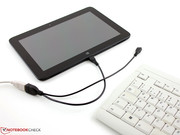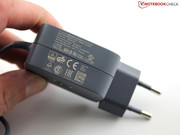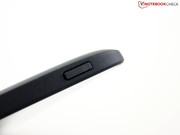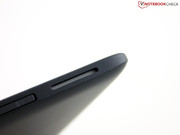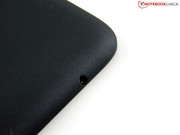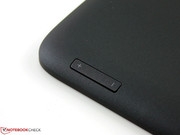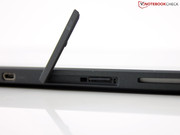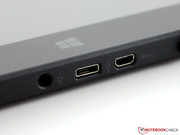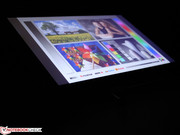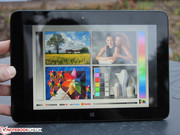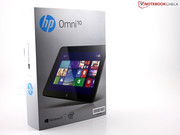Review HP Omni 10 5600eg (F4W59EA) Tablet

For the original German review, see here.
Where is the race headed? The dying Windows fan base has Microsoft and Intel worried: in five years, will we still have a large number of Intel-based Windows tablets? ARM/Tegra-based Android tablets or even the iPad have been turning up the heat for years. Unlike Intel's Atom platform for tablets (Clover Trail), the competition was able to record huge increases in sales.
How secure is a tablet with Windows for the future? At the end of 2012, Intel introduced the Clover Trail platform, which should be fit for Windows 8. During 2013, a multitude of tablets and convertibles came out, but they all had two problems: the performance was too low when compared to most Intel laptops and the pricing of 500 - 800 Euros (~$684 - $1094) was too high for such low performance.
Can the successor, Intel Bay Trail, resolve these two issues? The pricing has changed: the devices now cost 400 Euros (~$547), as can be seen from the Asus Transformer Book T100TA-C1-GR and the HP Omni 10 5600eg test model.
To rank the HP Omni 10 (399 Euros; ~$546), we use the Lenovo Miix 2 8 (8-inch, Z3740) and Asus Transformer Book T100TA-C1-GR convertible (10.1-inch, Z3740) for comparison. The Miix 2 is available for 300 Euros (~$410) and the Transformer Book for around 400 Euros (~$547). Does the buyer get a device that is secure for the future when s/he buys the Omni 10?
Case
A solid case, which does not deform when pressed, gives us the impression that this tablet PC is high quality. HP does everything right and the 10-inch device (661 grams; ~1.5 pounds) offers a good grip, thanks to the rubber cover on the back and the sides. A rubber border runs along the front of the display as well, but it alone cannot protect the screen from scratches. All-in-all, the use of rubber ensures that the user can hold the device securely.
High pressure on the back may lead to deformations on the panel. The same applies to the front: we need to push quite hard to cause deformations on the Full HD panel.
Connectivity
The chassis looks and feels compact, mainly due to the limited ports and buttons. HP does not offer buttons, like rotation lock. Power and a headphone jack are the only two features to be found on the right, left and top sides. The volume rocker has been placed at the top, on the back of the device.
Ports are on the bottom as well (see picture): the Micro SD card reader is seated under a flap. The positioning of the ports and buttons ensures that in our hands, the device feels compact and well designed. However, if it is placed on the table and connected to a charger or other peripheral devices, the user will face difficulties. The HP "charging station with back connector" costs 40 Euros (~$55), but USB and HDMI are not available. It seems as if HP does not want us to use the tablet for productive purposes.
Communication
The WLAN module is the Broadcom 802.11bgn SDIO adapter and has Bluetooth 4.0 on-board. The WLAN adapter does not perform well in our WLAN range test: in fact, at 15 meters (~49 feet) from the house, the Windows WLAN bars have only two bars (of five) left. At 10 meters (~33 feet) from the router, inside the house, we have four bars. This is quite poor range: the Transformer Book T100TA showed these results when we set the Fritz!Box router to 50% performance. However, we tested the Omni 10 at 100%.
Accessories
In our test, the Micro-A-USB to USB Type A cable of the Toshiba Satellite W30Dt-A-100 was very handy. We could connect USB input devices, external hard disks, USB sticks and even a hub thanks to it. The buyer has to buy such an adapter, as HP does not include anything other than a power adapter and an SD memory card (8 GB) with Windows Recovery Image in the delivery. The latter is a new feature for tablets, but HP had to include it as of the 28 GB total storage, only 10 GB are available to the user. As such, there was no room for the Recovery partition. The storage can be increased using the Micro SD slot (up to 64 GB cards - MicroSDXC). Alternatively, the buyers of the Omni 10 receive up to 25 GB free Cloud storage at Box.com. This is quite good, as usually it is a mere 5 GB.
What makes the Omni 10 so well rounded? The manufacturer has included MS Office Home & Student (Word, Excel, PowerPoint and OneNote full versions), HP Connected Photo, Connected Music, Box (up to 25 GB free Cloud storage), Skype and HP ePrint. These tools do not take much space: but the Windows folder does, as it requires 10 GB.
Warranty
HP offers a 12-month warranty (Pick-Up & Return). After registration, support will pick up the device. The warranty can be extended up to 24 months for 54 Euros (~$74) (HP 2-year Standard Exchange Service).
Webcam
The Omni 10 is equipped with two high-resolution cameras. The front is graced by a webcam, which offers a resolution of 1920x1080 pixels (2 MP). This is quite a lot more than what most laptops offer (usually HD - 1280x720 pixels = 0.9 MP). Two cameras are installed in the Lenovo Miix 2 8 tablet as well (Front 2 MP, Back 5.0 MP), but the quality is far lower. The Transformer cannot offer the same (only front camera - 0.9 MP).
The main camera on the rear offers 8 MP. The pictures have a resolution of 3264x1836 pixels and in daylight, with auto-focus set to high, the colors seem natural. However, the rear camera cannot match the different depth sharpness offered by an SLR. So if you want very sharp photos, look elsewhere as the main camera is more suited for snapshots, which can be shown off on the tablet.
Input Devices
Touchscreen
The touch-sensitive panel reacts quickly and recognizes up to 10 fingers simultaneously. However, the fingers do not always hit the desired spot, and we recommend adjusting the scaling of the symbols in Windows settings. The virtual keyboard is the Windows 8 standard and can be split into two. Thanks to the high resolution, even after the virtual keyboard pops up, the user will have a decent amount of work area left on the screen. This is not the case in the 8-inch Lenovo Miix 2. The windows key under the TFT often does not react and is supposed to show the Windows home screen (Metro tabs).
The following video shows the use of Windows 8.1 with scaling (web browsing and video). In the second part, the CPU stress test Prime95 and a high-resolution video run simultaneously, but this barely affects the system performance.
Display
The 10-inch display has a resolution of 1920x1200 pixels which translates to a pixel density of 220 ppi. The Transformer (155 ppi) and Miix 2 8 (188 ppi) cannot match this level. HP has chosen large symbols in the Windows settings, which comes as no surprise: our fingers could not pick out the right option from a small menu or file tree.
The black value of 0.43 cd/m² results in a contrast of 667:1. This is quite good, as even high-end tablets, like the Vaio Tap 11, can only offer 831:1. The Transformer Book takes the lead with 1,033:1 and the Miix 2 8 lies at the same level with 668:1.
| |||||||||||||||||||||||||
Brightness Distribution: 90 %
Center on Battery: 286 cd/m²
Contrast: 667:1 (Black: 0.43 cd/m²)
ΔE ColorChecker Calman: 5 | ∀{0.5-29.43 Ø4.79}
ΔE Greyscale Calman: 4.18 | ∀{0.09-98 Ø5}
42% AdobeRGB 1998 (Argyll 1.6.3 3D)
46.12% AdobeRGB 1998 (Argyll 3D)
66% sRGB (Argyll 3D)
44.5% Display P3 (Argyll 3D)
Gamma: 2.45
CCT: 6594 K
The brightness is higher than that of the Transformer, but it cannot match that of the Miix 2 (average 389 cd/m²). Thankfully, the illumination is well distributed and we did not notice any "bleeding" or clouding effects. A sensor next to the webcam allows the brightness to adjust itself automatically to the ambient lighting. This feature spares the eyes in the dark and saves on power.
The color space spectrum for sRGB and AdobeRGB are barely covered, like the competition. A mere 61% coverage of the sRGB color space is offered by the Omni 10. However, as this criterion is important mainly to professional picture editors, we feel it is secondary, as few such editors will want to work on an Atom-based tablet.
We could get more accurate measurements using the photo spectrometer. We did not notice a blue tinge, like in so many other models. On the contrary, the colors and gray tones are quite warm. The gray level measurement reveals that dark tones are represented exactly like in the reference. In fact, the average eye would not be able to distinguish between the TFT picture and a color map (starting at DeltaE >3). The ColorChecker also records a low DeltaE of 5. Lenovo can one up the competition: the Miix 2 8 lies at 2.4 on the gray scale in DeltaE and at 3.5 in the ColorChecker (mixed colors).
Outdoors, the good contrast and high brightness ensure good legibility. The Omni 10 works well when it is cloudy outside, but the glossy panel is prone to reflections when it is sunny out. The further to the side we look from, the harder it becomes to recognize the display content (picture 2).
Performance
HP seems convinced that they made the right pick: "The fast Intel Atom processor series Z3000 offers the best performance available for tablets today". The Intel Atom Z3770 (Bay Trail) is a quad-core SoC with Turbo: 1.46 to 2.4 GHz. The base clock speed is slightly higher than that of an Atom Z3740 (1.33 GHz; Miix 2 8, Transformer Book T100TA). We will see in the following sections if this difference in speed results in a significant performance gap.
The memory and storage are limited: 2 GB RAM (onboard) are not the maximum amount that can be supported on this platform (4 GB at LPDDR3-1066) and 32 GB eMMC flash storage is quite annoying. Due to the RAM installed, HP provides a 32-bit system. The Samsung flash storage has a mere 10 GB free and HP does not offer a larger alternative.
Processor
The Z3000 series from Intel is produced in the conservative 22 nm lithograph format as are the Haswell chips found in subnotebooks and notebooks. Intel mentions a TDP value of <4 W and the Scenario Design Power lies at a mere 2 W. Like the Haswell processors, the Bay Trail Atoms have Turbo: the Z3770 can operate at 1,460 - 2,400 MHz (Z3740: 1,330 – 1,860 MHz). Cinebench R10 and Geekbench show an increased performance of 17% over the Z3740 processor (three comparison devices). The older Z2760 is far behind at -55% and is placed right next to the AMD competitor A4-1200 with -58%.
How does Turbo perform at normal CPU load? In the single thread test, one core can run with up to 2.4 GHz. In the multithread test, the processor runs at 2.26 GHz at the start and then resets back to 1.465 GHz after a few minutes, and does not seem to go below this value (even on battery). We ran Cinebench R10 on battery and recorded the same scores.
| HP Omni 10 5600eg (F4W59EA) HD Graphics (Bay Trail), Z3770, 32 GB eMMC Flash | Toshiba Satellite W30Dt-A-100 Radeon HD 8180, A4-1200, WD Blue UltraSlim WD5000MPCK-22AWHT0 | Lenovo IdeaTab Miix 10 64GB SGX545, Z2760, 64 GB SSD | Asus Transformer Book T100TA-C1-GR HD Graphics (Bay Trail), Z3740, 32 GB eMMC Flash | Lenovo Miix 2 8 HD Graphics (Bay Trail), Z3740, 32 GB eMMC Flash | Toshiba Encore WT8-A-102 HD Graphics (Bay Trail), Z3740, 32 GB eMMC Flash | |
|---|---|---|---|---|---|---|
| Cinebench R10 | -52% | -54% | -20% | -18% | -18% | |
| Rendering Single 32Bit (Points) | 1230 | 753 -39% | 609 -50% | 940 -24% | 971 -21% | 963 -22% |
| Rendering Multiple CPUs 32Bit (Points) | 3939 | 1401 -64% | 1711 -57% | 3334 -15% | 3384 -14% | 3390 -14% |
| Geekbench 2 - 32 Bit | ||||||
| Total Score (Points) | 3106 | 1406 -55% | 1360 -56% | 2586 -17% | 2607 -16% | 2594 -16% |
| Geekbench 3 | ||||||
| 32 Bit Multi-Core Score (Points) | 3072 | 1000 -67% | 2617 -15% | |||
| Total Average (Program / Settings) | -58% /
-56% | -55% /
-54% | -17% /
-18% | -17% /
-17% | -17% /
-17% |
System Performance
"Unbelievably fast and intuitive - the HP Omni 10 offers next-gen performance thanks to the latest Intel Atom processor: the Z3000". This description on the product site will no doubt entice many a buyer. Laptop performance in a tablet form factor for less than 400 Euros (~$547)? Of course, the test model cannot live up to its claims entirely, but we cannot dispute one fact: the Omni 10 runs smoothly all the time or at least passably. The Omni can start up within 10 seconds and programs require a mere 2 - 3 seconds to start. In Windows 8, we could swap between open applications with the swish of a finger. Although, the feature was available in the predecessor as well, the performance was prone to breaking down and lagging due to the running of multiple programs simultaneously. A CPU test running in the background almost caused the system to crash.
Now Bay Trail ushers in a new era: we ran Prime95 Multi while playing an H264 video and surfing the web. This fluid experience was not possible with Cloverfield. Take a look at our video above (under input devices) - Prime95 is running in the background in the second part.
PCMark 7 assures us that the Omni 10 offers good performance. The System Storage Score is at the same level as that of the Miix 2 and Encore, and the Transformer Book lags behind a little. Furthermore, the higher performance results in a higher productivity: plus 10 - 18%. Overall, the Omni 10 can hold its own against all the competitors and even jump ahead (although 3% is a small gap). We also ran PCMark 8 on our test model, but not for the competitors.
| HP Omni 10 5600eg (F4W59EA) HD Graphics (Bay Trail), Z3770, 32 GB eMMC Flash | Toshiba Satellite W30Dt-A-100 Radeon HD 8180, A4-1200, WD Blue UltraSlim WD5000MPCK-22AWHT0 | Lenovo IdeaTab Miix 10 64GB SGX545, Z2760, 64 GB SSD | Asus Transformer Book T100TA-C1-GR HD Graphics (Bay Trail), Z3740, 32 GB eMMC Flash | Lenovo Miix 2 8 HD Graphics (Bay Trail), Z3740, 32 GB eMMC Flash | Toshiba Encore WT8-A-102 HD Graphics (Bay Trail), Z3740, 32 GB eMMC Flash | |
|---|---|---|---|---|---|---|
| PCMark 7 | -66% | -37% | -13% | -3% | -3% | |
| Score (Points) | 2568 | 1011 -61% | 1413 -45% | 2339 -9% | 2505 -2% | 2497 -3% |
| Productivity (Points) | 1199 | 303 -75% | 600 -50% | 983 -18% | 1072 -11% | 1080 -10% |
| System Storage (Points) | 3665 | 1373 -63% | 3094 -16% | 3255 -11% | 3825 4% | 3806 4% |
| PCMark 7 Score | 2568 points | |
| PCMark 8 Home Score Accelerated | 1613 points | |
| PCMark 8 Work Score Accelerated | 2404 points | |
Help | ||
Storage Device
HP employs cheap eMMC storage: a 32 GB Samsung module (MBG4GC). We previously tested this module in the Surface 2 and the Toshiba Encore. In comparison to the competition, the storage is not so bad, but as the eMMC storage is a low-cost solution, the write and read rates are much lower than that of a SSD (like an mSATA drive). We did like the good Read 4K and Write 4K speeds. The Miix 2 8 can top it - it offers 9% faster storage.
The SDXC card reader is a way to easily upgrade the capacity of the test model. In our test, we could read a 64 GB SDXC, but at far lower speeds than those offered by the eMMC storage. 23 MB/s (Samsung SD) in sequential read are trumped by the 82 MB/s of the Samsung eMMC. The 5.1 MB/s (SD) in 4K Read test are close to the 11 MB/s of the eMMC. Writing to the SD card takes much longer than on the eMMC: 0.9 versus 9 MB/s.
| HP Omni 10 5600eg (F4W59EA) HD Graphics (Bay Trail), Z3770, 32 GB eMMC Flash | Lenovo IdeaTab Miix 10 64GB SGX545, Z2760, 64 GB SSD | Toshiba Satellite W30Dt-A-100 Radeon HD 8180, A4-1200, WD Blue UltraSlim WD5000MPCK-22AWHT0 | Asus Transformer Book T100TA-C1-GR HD Graphics (Bay Trail), Z3740, 32 GB eMMC Flash | Lenovo Miix 2 8 HD Graphics (Bay Trail), Z3740, 32 GB eMMC Flash | |
|---|---|---|---|---|---|
| CrystalDiskMark 3.0 | -22% | -16% | -9% | 9% | |
| Read 512 (MB/s) | 83.9 | 74.1 -12% | 30.38 -64% | 104.7 25% | 82.2 -2% |
| Write 512 (MB/s) | 30.9 | 32.9 6% | 42.43 37% | 18.93 -39% | 39.57 28% |
| Write Seq (MB/s) | 48.04 | 38.14 -21% | 99.7 108% | 43.2 -10% | 50.3 5% |
| Read Seq (MB/s) | 82.7 | 77.5 -6% | 89.9 9% | 109 32% | 86.6 5% |
| Write 4k (MB/s) | 9.119 | 2.226 -76% | 0.921 -90% | 4.034 -56% | 11.19 23% |
| Read 4k (MB/s) | 11.07 | 8.57 -23% | 0.34 -97% | 10.33 -7% | 10.14 -8% |
Graphics Card
The HD Graphics (Bay Trail) is integrated into the SoC (System-on-Chip). The chip is responsible for DirectX-11-Support, video playback and the control of high-resolution display (up to 2560x1600 pixels). The performance is low: at the level of an HD 8180 (A4-1200). The HD Graphics of the Z3740 delivers roughly the same scores in all the GPU benchmarks.
| HP Omni 10 5600eg (F4W59EA) HD Graphics (Bay Trail), Z3770, 32 GB eMMC Flash | Lenovo IdeaTab Miix 10 64GB SGX545, Z2760, 64 GB SSD | Toshiba Encore WT8-A-102 HD Graphics (Bay Trail), Z3740, 32 GB eMMC Flash | Toshiba Satellite W30Dt-A-100 Radeon HD 8180, A4-1200, WD Blue UltraSlim WD5000MPCK-22AWHT0 | Asus Transformer Book T100TA-C1-GR HD Graphics (Bay Trail), Z3740, 32 GB eMMC Flash | Lenovo Miix 2 8 HD Graphics (Bay Trail), Z3740, 32 GB eMMC Flash | |
|---|---|---|---|---|---|---|
| 3DMark 11 | ||||||
| 1280x720 Performance GPU (Points) | 171 | 178 4% | 184 8% | |||
| 3DMark 06 | ||||||
| 1280x1024 Standard Score AA:0x AF:0x (Points) | 1899 | 421 -78% | 1869 -2% | 1726 -9% | 1868 -2% | |
| 3DMark | -77% | -10% | 3% | 5% | 7% | |
| 1280x720 Cloud Gate Standard Graphics (Points) | 1201 | 1182 -2% | 1477 23% | 1204 0% | 1224 2% | |
| 1280x720 Ice Storm Standard Score (Points) | 14632 | 3420 -77% | 12171 -17% | 12125 -17% | 15966 9% | 16401 12% |
| Total Average (Program / Settings) | -78% /
-78% | -6% /
-7% | -3% /
-1% | 2% /
3% | 8% /
7% |
| 3DMark 03 Standard | 5188 points | |
| 3DMark 06 Standard Score | 1899 points | |
| 3DMark 11 Performance | 202 points | |
| 3DMark Ice Storm Standard Score | 14632 points | |
| 3DMark Cloud Gate Standard Score | 1252 points | |
Help | ||
| low | med. | high | ultra | |
|---|---|---|---|---|
| Tomb Raider (2013) | 13.4 | 7 |
Emissions
System Noise
The Omni 10 is silent as there is no fan and the model has no moving parts.
Temperature
The small case cools the components passively, which is why the temperatures can rise quite a bit if the model is at high load for long periods of time. The hotspot lies in the middle: 55 °C (131 °F). We measure a temperature difference of 24 °C (75.2 °F) between the idle and stress states of the test model (based on the average values). The idle temperature of 28 degrees (82.4 °F) on the top and bottom of the model is noticeable as competitors like Lenovo Miix 2 8 and Transformer Book have far lower values.
A stress test (Prime95 and FurMark run simultaneously) allows us to check the temperatures and clock speeds at high load. When the test begins, the clock speed is 2.26 GHz. The CPU temperature rises to 87 °C (188.6 °F) within a few minutes. At this point, throttling kicks in, and the clock speed drops to 1,088 MHz. As the high load continues, the clock speed drops even further, down to 666 - 933 MHz where it fluctuates. This occurs after about an hour. This throttling did not occur in the previous tests, which is why the Omni 10 scores so well in the CPU benchmarks. The run time of the benchmarks was around 10 minutes, but the GPU was not stressed during these tests.
Right after the stress test, we ran 3DMark 2006 again and the Omni 10 achieved the same scores as in its cold state. This means that the high temperatures quickly dissipate, allowing the CPU to reach its high clock speeds.
(+) The maximum temperature on the upper side is 39.5 °C / 103 F, compared to the average of 33.7 °C / 93 F, ranging from 20.7 to 53.2 °C for the class Tablet.
(-) The bottom heats up to a maximum of 55.2 °C / 131 F, compared to the average of 33.2 °C / 92 F
(+) In idle usage, the average temperature for the upper side is 27.6 °C / 82 F, compared to the device average of 30 °C / 86 F.
Speakers
The small speakers at the bottom of the tablet (not back) are placed inside two long openings. The volume can fill a 20 m² (215 sq ft) room without issues, which is good for presentations. Sadly, the sound output is not great. The small membranes of the speakers overtone and screech at maximum volume. They stress the middles and lack highs and bass.
Energy Management
Power Consumption
While idle, the Omni 10 requires 2.1 W (minimum). The Miix 2 and Transformer Book T100TA perform better: 1.2 and 1.7 W respectively. The competitors have an advantage due to their lower resolutions and/or smaller screen size (8-inch for the Miix 2). At load, they require less power, mainly due to the lower Turbo clock speed of their Z3740 (1.8 instead of 2.4 GHz). All together, the models are quite conservative, especially the 8-inch Miix 2 and Toshiba Encore. The Satellite W30Dt-A-100 is not a suitable model for comparison as it is a 13.3-inch convertible with a rotating HDD in its heavy chassis. Still, it serves as a good example of how far behind APUs are (in performance-per-Watt) to the second Atom generation for tablets.
The identical values at max load are understandable due to the throttling of our test model. The test model briefly sucks in 15.1 Watts, but it quickly goes down to 12.8 W again.
| HP Omni 10 5600eg (F4W59EA) HD Graphics (Bay Trail), Z3770, 32 GB eMMC Flash | Toshiba Satellite W30Dt-A-100 Radeon HD 8180, A4-1200, WD Blue UltraSlim WD5000MPCK-22AWHT0 | Asus Transformer Book T100TA-C1-GR HD Graphics (Bay Trail), Z3740, 32 GB eMMC Flash | Lenovo IdeaTab Miix 10 64GB SGX545, Z2760, 64 GB SSD | Lenovo Miix 2 8 HD Graphics (Bay Trail), Z3740, 32 GB eMMC Flash | Toshiba Encore WT8-A-102 HD Graphics (Bay Trail), Z3740, 32 GB eMMC Flash | |
|---|---|---|---|---|---|---|
| Power Consumption | -102% | 17% | 20% | 35% | 33% | |
| Idle Minimum * (Watt) | 2.1 | 6.3 -200% | 1.7 19% | 1.8 14% | 1.2 43% | 1.3 38% |
| Idle Average * (Watt) | 4.6 | 9.7 -111% | 3.9 15% | 4.7 -2% | 2.8 39% | 2.8 39% |
| Idle Maximum * (Watt) | 5.5 | 11.9 -116% | 3.9 29% | 4.7 15% | 3.1 44% | 3.1 44% |
| Load Average * (Watt) | 12.8 | 17.4 -36% | 10.7 16% | 7.4 42% | 8.9 30% | 8.8 31% |
| Load Maximum * (Watt) | 12.8 | 19 -48% | 11.8 8% | 8.7 32% | 10.3 20% | 11.4 11% |
* ... smaller is better
| Off / Standby | |
| Idle | |
| Load |
|
Key:
min: | |
Battery Life
The battery life of the Omni 10 (31 Wh; 4:55 hours WLAN test) will not earn it any trophies. The competitors can last 54% (Miix 2 8: 17.5 Wh) and 119% (Transformer Book T100TA: 30 Wh) longer. This applies to the WLAN test, in which the Omni 10 was set to 150 cd/m² brightness and a script would load websites at a certain frequency (sometimes playing videos). While idle, the competitors are no longer as far apart: the Transformer Book lasts 33% longer and the Miix 2 8 lasts 18% longer.
The 18 W power adapter requires five whole hours to charge the tablet from empty. This is approximately the battery life one can expect while surfing via WLAN.
| HP Omni 10 5600eg (F4W59EA) HD Graphics (Bay Trail), Z3770, 32 GB eMMC Flash | Lenovo IdeaTab Miix 10 64GB SGX545, Z2760, 64 GB SSD | Toshiba Satellite W30Dt-A-100 Radeon HD 8180, A4-1200, WD Blue UltraSlim WD5000MPCK-22AWHT0 | Lenovo Miix 2 8 HD Graphics (Bay Trail), Z3740, 32 GB eMMC Flash | Toshiba Encore WT8-A-102 HD Graphics (Bay Trail), Z3740, 32 GB eMMC Flash | Asus Transformer Book T100TA-C1-GR HD Graphics (Bay Trail), Z3740, 32 GB eMMC Flash | |
|---|---|---|---|---|---|---|
| Battery runtime | 17% | 18% | 22% | 47% | 62% | |
| Reader / Idle (h) | 12.6 | 14.7 17% | 10.8 -14% | 14.9 18% | 16.7 33% | |
| WiFi (h) | 4.9 | 5.5 12% | 7.2 47% | 7.6 55% | 7.2 47% | 10.8 120% |
| Load (h) | 3.2 | 3.9 22% | 3.9 22% | 3 -6% | 4.3 34% |
Verdict
The test model can hold its own. The times are gone when starting a program would take ages and the user would have to wait patiently while a blank window in front of him slowly added content. Bay Trail makes the tablets fit for multi-tasking. Up till today, we recommended staying away from the Intel Atom tablets as they could not offer a smooth Windows experience, but this 10-inch model from HP has changed our mind: for 400 Euros (~$547), it is cheaper than the Clovertrail tablets and performs far better. The test model is equipped with a Full HD panel with strong colors and the run times of up to 5 hours are acceptable. The 8 MP main camera captures decent pictures and finally MS Office is a nice addition (like in other tablets, it is the Home & Student license).
The biggest flaw of our test model is its low capacity (32 GB, which can be extended using the SD slot by up to 64 GB). The positioning of the ports at the bottom of the tablet makes it hard to use the model as a stationary PC. HP offers a charging station, but this blocks the USB and HDMI port. If you want to use the Omni 10 with an external display, keyboard and peripherals, then we advise putting together a tablet stand.
The Asus Transformer Book T100TA-C1-GR is suited for all users who are looking to be productive with a tablet and a docked keyboard. Asus offers two configurations: 64 GB or 564 GB (64 GB eMMC plus HDD in docking keyboard). The IPS panel only supports HD resolution. The second advantage of the Transformers: the battery life is double as long.
The Lenovo Miix 2 8 is suitable for those users who are constantly on the move. This 8-inch device lasts a good 7:34 hours and thus beats the Omni 10 in this department. Furthermore, it weighs a mere 340 grams (~0.75 pounds). However, the camera is not so good and it lacks a display out.




